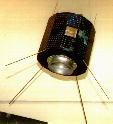![[German Museum Bonn]](../bilder/dm-bonn-small.gif)
![[University of Bonn]](../bilder/fr_wilh_trans.gif)
![[Carnegie Mellon University]](../bilder/scsbannertrans.gif)
![[German Museum Bonn]](../bilder/dm-bonn-small.gif) |
![[University of Bonn]](../bilder/fr_wilh_trans.gif) |
![[Carnegie Mellon University]](../bilder/scsbannertrans.gif) |

BREM-SAT represented a new type of satellite. With a weight of only 63 kg and a diameter of just half a metre, it was smaller and lighter than conventional satellites. This was the first time that a compact satellite had been used not for telecommunications but for stand-alone experiments.
It remained in space for just one year, use being made of every phase of its flight. BREM-SAT measured micrometeorites and rocket particles, tested the temperature endurance of CFCsubstitutes, and recorded the erosive effect of atomic oxygen.
On re-entering the atmosphere on 12 February 1995, BREM-SAT burnt up over the Pacific. During the last phase of its flight, the satellite was still transmitting data on its own temperature down to a height of 110 km.